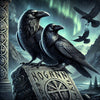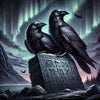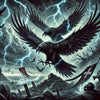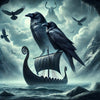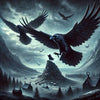Meaning and Symbolism of the Norse Compass: A Comprehensive Guide
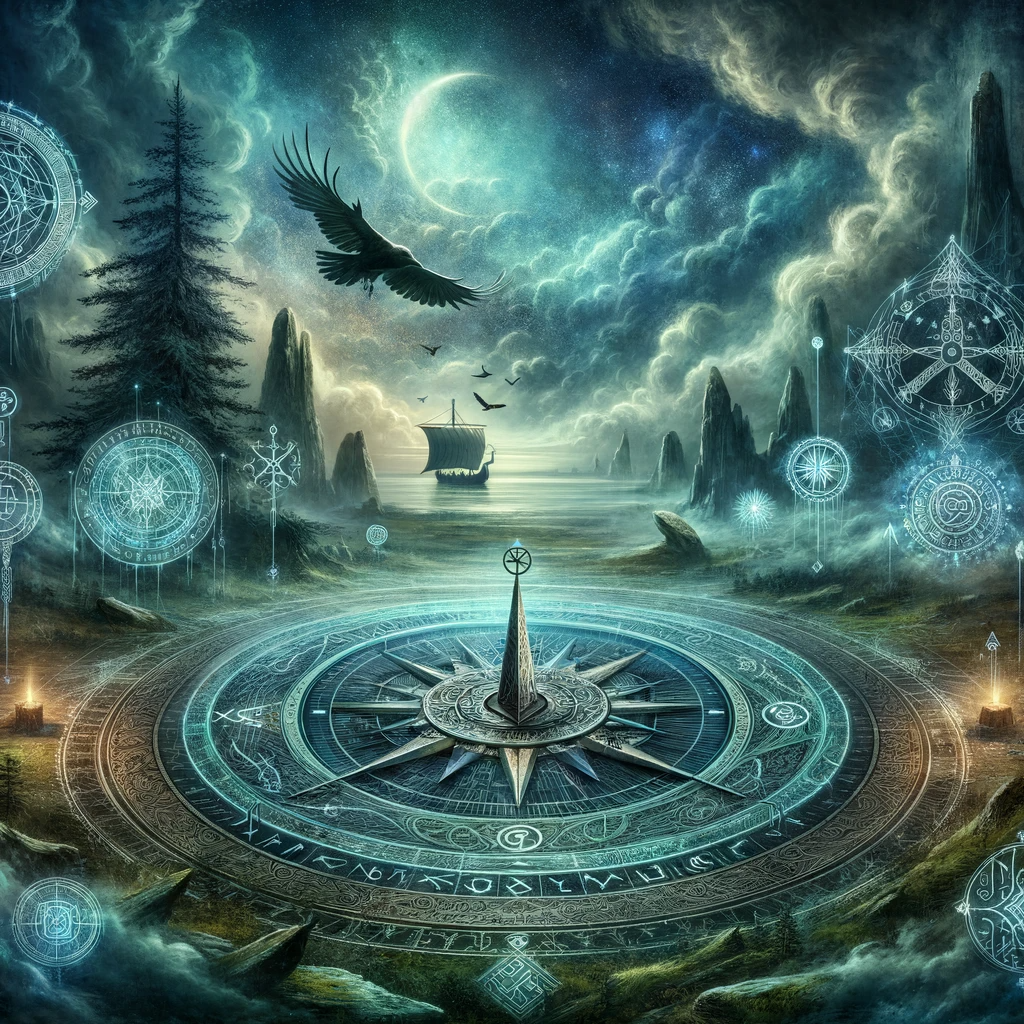
Navigating the Mysteries of the Norse Compass: History, Symbolism, and Modern Significance
Imagine sailing the rough seas, guided not only by the stars but also by an ancient Norse compass. This isn't just any compass; it's the "Viking compass," a tool that transcends navigation, delving deep into symbolism, spirituality, and a rich history.
In the pages ahead, we're embarking on an exciting journey to demystify the Norse compass. Beyond its practical use, it's a treasure trove of runic symbols and hidden meanings, offering a glimpse into an era long gone.
Whether you're a history buff, a fan of Norse culture, or just curious about the past, you're in for a treat. Together, we'll decipher runic codes, explore the compass's protective and spiritual significance, and uncover its secrets.
As we set sail into this exploration, we invite you to join us on a voyage through time where history, symbolism, and spirituality collide in a fascinating tale.
Section 1: The Norse Compass in Context
The Norse compass, often affectionately known as the "Viking compass," wasn't just a handy tool for seafaring adventurers. It was a vital element of the Norse world, a piece of equipment that held both practical and symbolic significance.
Historical Significance
The Norse compass emerged during the Viking Age, a time when fearless Norse explorers set sail across vast and often treacherous waters in search of new lands and riches. It was a period marked by unparalleled maritime prowess, and the Norse compass played a pivotal role in these seafaring adventures.
Navigating the Unknown
Navigation during the Viking Age was a daring endeavor, relying on the keen observation of natural phenomena such as stars, landmarks, and, of course, the Norse compass. Unlike the magnetic compass we're familiar with today, the Norse compass operated on a different principle, aligning itself with the North Star and aiding sailors in finding their way even in the darkest of nights.
A Cultural Icon
Beyond its practical utility, the Norse compass became a cultural icon, symbolizing the indomitable spirit of the Norse people. It represented their adventurous nature, their mastery of the seas, and their connection to the cosmos.
The Link to Norse Mythology
To fully appreciate the Norse compass, we must look to the heart of Norse mythology. The compass, with its cardinal directions and runic inscriptions, was deeply intertwined with the mythology of the time. It was seen as a conduit between the earthly realm and the mystical world of the gods.
As we sail further into the depths of the Norse compass's history, we begin to uncover its roots in a culture that prized exploration and a spirituality that transcended the material world. Join us on this voyage as we continue to unravel the layers of symbolism and meaning behind this remarkable artifact.
Section 2: The Runic Symbols
One of the most captivating aspects of the Norse compass is the intricate runic symbols that adorn it. These symbols are more than just decorations; they carry profound meanings and play a crucial role in the compass's function and symbolism.
Deciphering the Runes
The runic symbols on the Norse compass are not mere ornamental designs. Each rune represents a letter of the runic alphabet, known as the "Elder Futhark." These ancient symbols held great significance in Norse culture, often associated with magic, divination, and communication with the spiritual world.
Algiz (ᚨ) - The Protective Rune
Among the runic symbols on the Norse compass, Algiz stands out as a symbol of protection. Shaped like an arrow pointing upwards, it is believed to guard against harm and guide the bearer safely through challenges and perils.
Raido (ᚱ) - The Journey Rune
Raido, resembling an 'R,' represents the journey itself. It signifies movement, travel, and the path one takes in life. When found on a Norse compass, it suggests that the voyage is not just about reaching a destination but the experiences gained along the way.
Thurisaz (ᚦ) - The Gateway Rune
Thurisaz, resembling a thorn, serves as a symbol of protection and defense. It is often associated with the idea of a gateway or a barrier. On the Norse compass, this rune may represent the threshold between the known and the unknown.
Mannaz (ᛘ) - The Self Rune
Mannaz, shaped like 'M,' symbolizes the self and human connections. When found on a Norse compass, it may suggest a connection between the individual's journey and their inner self or their role in the grand tapestry of life.
These runic symbols, etched with intention and meaning, transform the Norse compass into a profound spiritual tool. As we continue our exploration, we'll decode more of these intriguing runes and unveil the layers of symbolism and guidance they provide to those who dare to set sail with the Viking compass.
Section 3: The Four Cardinal Directions
The Norse compass, a beacon of guidance for ancient voyagers, is intimately linked to the four cardinal directions: North, South, East, and West. These directional markers hold deep symbolism within Norse culture, offering insights into the compass's spiritual significance.
North (Norðr) - The True North
In the Norse compass, North (Norðr) is the focal point, aligning with the North Star, Polaris. This direction represents stability, guidance, and the unchanging center of the cosmos. For Norse sailors, it was the North Star that provided a fixed point of reference amidst the ever-shifting sea.
South (Súð) - The Opposite Pole
South (Súð) on the Norse compass is the polar opposite of North. It signifies contrast and balance, offering a complementary force to the steadfastness of the North. In Norse symbolism, South represents warmth, growth, and the sun's influence.
East (Aust) - The Dawn of Possibilities
East (Aust) is where the sun rises, symbolizing new beginnings, hope, and the potential for growth. It's the direction that heralds the dawn of a new day and opportunities on the horizon.
West (Vestr) - The Land of Twilight
West (Vestr) is where the sun sets, signifying closure and the end of a journey. It's associated with reflection, endings, and the transition from the day's light to the night's darkness.
Section 4: Protective and Spiritual Symbolism
Beyond its practical purpose, the Norse compass is imbued with protective and spiritual symbolism. These elements add depth to its significance, making it more than just a navigational tool.
Guardian of the Voyage
The Norse compass is often viewed as a guardian of voyages. Sailors believed that it possessed the power to protect them from the perils of the sea. It symbolizes the watchful eye that guides them safely through turbulent waters.
Connection to the Spirit World
With its runic symbols and alignment to the North Star, the Norse compass was seen as a bridge between the physical and spiritual realms. It facilitated communication with the unseen forces of the cosmos and the gods of Norse mythology.
Personal Guidance
The Norse compass also carries the idea of personal guidance. It's not just about navigating the physical world but finding one's true path in life. It encourages introspection and self-discovery, guiding individuals on their unique journeys.
Symbol of Resilience
In Norse culture, resilience in the face of adversity was highly esteemed. The Norse compass embodies this resilience, as it was used by intrepid explorers who braved the unknown. It serves as a symbol of strength and determination.
A Source of Comfort
The Norse compass also provided comfort to sailors during long and arduous journeys. It was a tangible reminder of their connection to their homeland, their culture, and the hope of returning safely.
Section 5: Variations and Regional Differences
The Norse compass, like the culture it represents, has variations and regional differences that add even more intrigue to its story. Let's explore how this remarkable artifact took on different forms and meanings across the Norse world.
Regional Variations
One fascinating aspect of the Norse compass is its regional diversity. Different Norse communities crafted their compasses with distinct styles and symbols, reflecting their unique traditions and beliefs. These regional variations offer a glimpse into the cultural diversity within the Norse world.
The Norse Diaspora
As Norse explorers ventured beyond their homelands, the Norse compass traveled with them. It found its way to distant lands and cultures, influencing the compasses of other seafaring peoples. This diaspora of the Norse compass showcases its far-reaching impact.
Symbolic Variations
The symbols and runes on the Norse compass could also vary in meaning and interpretation. What held a specific significance in one region might have a different connotation elsewhere. These symbolic variations add layers of complexity to the compass's story.
Materials and Craftsmanship
The materials used and the craftsmanship applied to create the Norse compass could differ significantly from region to region. Some compasses were intricately carved from wood, while others were fashioned from metal. These differences in materials speak to the resourcefulness and craftsmanship of Norse communities.
Cultural Significance
The regional differences in Norse compasses often reflect the unique cultural priorities and values of each community. Exploring these differences allows us to gain a deeper understanding of the multifaceted nature of Norse culture and its interconnectedness.
Section 6: Modern Interpretations
The Norse compass, once an essential tool for ancient voyagers, continues to resonate with modern individuals in unique and compelling ways. In this section, we'll explore how the Norse compass is interpreted and cherished in contemporary times.
Beyond Navigational Tools
While modern navigation relies heavily on GPS and advanced technology, the Norse compass remains relevant as a symbol of tradition and heritage. It serves as a reminder of the intrepid explorers who once relied on its guidance.
Spiritual and Personal Growth
For some, the Norse compass has taken on a deeper spiritual significance. It is seen as a guide for personal growth and self-discovery. People turn to the compass for inspiration and direction in their life's journey.
Artistic Expression
The aesthetics and symbolism of the Norse compass have inspired artists, craftsmen, and tattoo enthusiasts alike. Its intricate designs and rich history make it a popular choice for those seeking to express their connection to Norse culture.
Jewelry and Accessories
Norse compass-themed jewelry and accessories have become fashion statements and symbols of personal identity. These pieces often incorporate runic symbols and compass imagery, allowing individuals to carry the spirit of the Norse compass with them.
Cultural Revival
The interest in Norse culture and heritage has experienced a resurgence in recent years. The Norse compass is a part of this revival, with enthusiasts and cultural preservationists celebrating its history and significance.
Conclusion
In our journey through the intricate world of the Norse compass, we've unearthed a treasure trove of history, symbolism, and cultural significance. From its humble beginnings as a navigational tool during the Viking Age to its modern interpretations, the Norse compass has proven itself as a timeless symbol of guidance and exploration.
As we've seen, this unassuming artifact is much more than a mere compass. It is a reflection of the Norse spirit—fearless, inquisitive, and deeply connected to the natural and spiritual worlds. The runic symbols etched onto its surface tell stories of protection, personal growth, and the resilience of those who dared to explore uncharted territories.
The four cardinal directions—North, South, East, and West—marked not only the way but also the profound connection between Norse culture and the cosmos. The Norse compass offered protection to seafarers, bridged the gap between the physical and spiritual realms, and provided comfort during long and perilous journeys.
Variations and regional differences in the Norse compass reveal the rich tapestry of Norse culture, showcasing the diversity and interconnectedness of different communities within the Norse world. It serves as a testament to the adaptability and creativity of the Norse people.
In modern times, the Norse compass lives on, not just as a relic of the past but as a source of inspiration, guidance, and artistic expression. Its symbolism transcends time and continues to resonate with those seeking direction, self-discovery, and a connection to their heritage.
As we conclude our exploration of the Norse compass, we invite you to carry its spirit with you. Whether you're drawn to its historical significance, its protective symbolism, or its role in modern culture, the Norse compass remains a timeless emblem that speaks to the adventurous and inquisitive spirit in all of us.
So, set your course, whether on the open sea or the journey of life, with the wisdom and symbolism of the Norse compass as your guide. Just as the ancient Norse mariners once relied on its direction, you too can find your path, embrace your journey, and navigate the vast expanse of possibilities that lie ahead.
Thank you for joining us on this voyage through time and symbolism, where the history of the Norse compass meets the curiosity of the present day. May your path be ever-guided by the wisdom and resilience of those who came before us.


